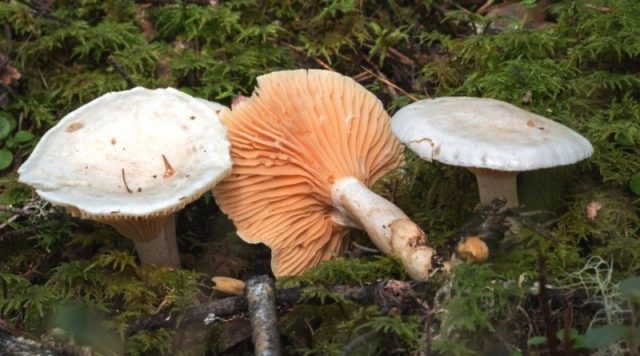Content
Meadow gigrofor is one of the representatives of the Gigroforov family. Belongs to the category of rare mushrooms. In other sources, it can be found under the name meadow hygrocybe or meadow cuffhyllum. It grows mainly in small groups. The official name is Cuphophyllus pratensis.
What does meadow hygrophor look like?
The fruiting body of this species is of a standard shape. Its color ranges from golden to light brown, depending on growing conditions. The hat at a young age has a very convex shape with the edges bent down. But later it opens up and flattens. In adult specimens, only a small tubercle remains in the center, and the edges become sharp and thin. In high humidity, the cap is slippery and shiny.
On the reverse side of the upper part, you can see rare thick plates descending to the stem. They are dense to the touch, and their color is slightly lighter than the cap. When broken, you can see the pulp of a light yellow shade of dense consistency. Its color does not change upon contact with air. The pulp has a pleasant taste and exudes a slight mushroom odor.
The spores of the meadow hygrophor are colorless, smooth. Their shape resembles an ellipse, and the size is 5-7 x 4-5 microns.
The leg of this species is cylindrical, slightly narrowed at the base. Its length is 4-8 cm, and its thickness is 0.5-1.2 cm. It has a pale yellow color.

Gigrofor meadow grows in thickets of grass, for which it got its name
Where does the meadow hygrophor grow
This species grows in grass in meadows and pastures. Sometimes it can be found in light plantings of a mixed type, but this is more an accident than a pattern.
Meadow gigrofor can be found in:
- Europe;
- North and South America;
- New Zealand;
- North Africa;
- Australia;
- North Asia.
Is it possible to eat meadow hygrophor
This mushroom is edible. In terms of taste, it belongs to the third category, so it is in no way inferior to autumn mushrooms. It can be consumed without fear for your health. However, when collecting, it is better to give preference to young specimens, since their taste is richer.
False doubles
This species is in many ways similar to its relative Karsten hygrophor. In the latter, the shade of the fruiting body is light apricot, and the plates are pale pink. The diameter of the cap is 3-7 cm. The stem is whitish, tapering at the base. The twin is also an edible mushroom.
This species grows in coniferous forests with a developed moss cover, prefers spruce forests. Widespread in Finland. The official name is Hygrophorus karstenii.

Gigrofor Karstena is especially good fried and stewed, but can also be eaten fresh
Collection rules and use
The fruiting period of the meadow hygrophor begins in July and lasts until October, if weather conditions favor it. When collecting, it is necessary to cut it off at the base with a sharp knife so as not to disturb the mycelium.It is necessary to fold the meadow hygrophor into the basket with the caps down, so as not to break, since even with a slight physical impact, it crumbles.
Before cooking, mushrooms should be thoroughly cleaned of forest litter and soil. In addition, it is necessary to remove the top slippery film from the cap, and then wash thoroughly. Gigrofor meadow is suitable for any kind of processing, while it retains a dense pulp consistency. It also keeps well when dried.
Conclusion
Meadow gigrofor is an edible mushroom that can compete with many known species. But he is often simply invisible to lovers of quiet hunting. This is due to the fact that many mushrooms that grow in open areas by force of habit remain unattended.








